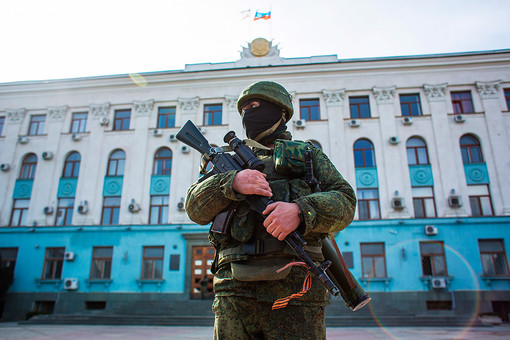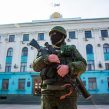
Myth and Reality—A Net Assessment of Russia’s ‘Hybrid Warfare’ Strategy Since the Start of 2014 (Part One)
Publication: Eurasia Daily Monitor Volume: 11 Issue: 184
By:

Russian commentators noted the significance of President Vladimir Putin’s mid-October decision to order troops back to their bases after several months of high readiness in proximity to the Russia-Ukraine border. Military forces in the area were placed on high alert in the run-up to the Winter Olympic Games in Sochi in February 2014 and were maintained at such levels since. Although it may not signal the end of the crisis, and was most likely triggered by the agreement to hold a bilateral meeting between President Putin and his Ukrainian counterpart, Petro Poroshenko, in Milan, it presents an opportunity to reflect on Russia’s use of military power during the crisis since the start of the year (gazeta.ru, October 13).
Essential in such reflections on the success of Moscow’s policy to annex Crimea, destabilize eastern and southeastern Ukraine, and fundamentally challenge post-Cold War European security architecture is the concept and mythology which developed around the phrase “hybrid warfare.” At an early stage, following the sudden appearance of the “polite people”—denoting the Russian military deployment across the Crimean peninsula in late February and March 2014—this phrase came into Western parlance. In fact, “hybrid warfare” reflects two quite distinctive and misleading articles in the Russian media: one by Putin’s close advisor Vladislav Surkov (under a pseudonym) and the other, written one year earlier, allegedly by the chief of the General Staff (CGS), Army-General Valeriy Gerasimov. Surkov’s phrase, in a futuristic piece written in March 2014, used the term “non-linear” warfare, marking something new in Russian conventional operations. While the term also appeared in the thinking expressed under Gerasimov’s name in February 2013 (ruspioner.ru, March 12; Voyenno-Promyshlennyy Kuryer, February 27, 2013).
Surkov’s phrase, following the surprise activities in Crimea, which marked Moscow’s annexation of the territory, was seized upon by commentators in search of a convenient hook to make sense of rapidly unfolding developments. Moreover, many pointed to the holy grail of “non-linear” warfare, preferring the term “hybrid warfare” while appealing to the Gerasimov article from February 2013 in Voyenno-Promyshlennyy Kuryer. Unfortunately, the search is somewhat misleading for a number of salient reasons: Gerasimov was only in the post for three months at that point. Second, he was not known for advanced thinking on future warfare developments. And finally, there is a long tradition established in the Soviet era of lower-ranking General Staff officers publishing under the name of the CGS. Consequently, those who rushed for easy interpretations of the Russian tactics used in Ukraine coined the phrase: “Gerasimov doctrine,” as one explainer. However, many of the features of the Russian operations in Crimea, for instance, were put in place by Gerasimov’s predecessor Nikolai Makarov (Voyenno-Promyshlennyy Kuryer, February 27, 2013).
The Russian Federation’s aggression toward Ukraine swung between unconventional and conventional warfare. Russia absorbed Crimea and subsequently carried out operations to promote “rebel forces” in Ukraine in what appeared as a war for “Novorossiya” (“New Russia”—a historical name for lands occupying mainly southeastern Ukraine), with ever increasing gains on the ground for the pro-Russia elements within Ukraine’s east. Russian actions ranged from the use of “polite people” or a new special forces mix in Crimea, to a threat of full-scale invasion by combined-arms units in the Donbas region—and included high-profile “humanitarian convoys” used to great effect (see EDM, September 2). The actual use of Russian troops within Ukraine amounted to a relatively small force, compared to the high-readiness combined-arms units closer to the border. These operations themselves ranged from conventional through to special forces operations, combined with an ongoing information campaign aimed at destabilization Ukraine and combatting the West’s narrative of the conflict (see EDM, July 8).
Russian and Western commentators quickly lost sight of how the Crimea operation was handled and precisely why it was so effective. They overlooked the actual force mix that was utilized in conjunction with the Kremlin’s mixture of hard and soft power to slice off part of the territory of a neighboring state and apply continued pressure on the government in Kyiv. Slogans about “polite people” and references to “non-linear war” masked the actual nature of executing such operations. By April 2014, Russia’s political-military elite were so buoyed by the confidence of this experiment in harnessing hard and soft power that they were poking fun at leaders of the North Atlantic Treaty Organization (NATO) who were condemning Russian actions in Ukraine. Defense Minister Sergei Shoigu dismissed the West’s search for Russian military involvement in eastern Ukraine as like looking for “a black cat in a dark room,” while offering admiration for Russian special forces, by acknowledging that such black cats are “smart, polite and brave” (see EDM, April 23).
Blurring Russian military theory, doctrine, capabilities and force development with the opinions of Moscow media in a full blown information campaign became a matrix for explaining the on-the-ground activities of Russian units. But this explanation eclipsed many of the real themes present in the original “Gerasimov” article. These are worth noting in order to reach a proper understanding of the use of unconventional tactics to good effect in Crimea and later in destabilizing eastern and southeastern Ukraine (EDM, June 17; EDM, June 12).
The problem is that the Gerasimov article does not entirely fit Russian operations in Ukraine. Its context, with references to Russian thinking on future warfare as well as efforts to bolster military science and the domestic defense industry, are vital clues in the reading of the piece. A dominant theme in this discourse, reinforced by the need to stress continuity with the previous CGS, is the interest in both network-centric and non-linear warfare—themes present in the Armed Forces reform launched in 2008 and the subsequent military modernization to 2020. Moreover, these ideas and concepts were not developed in a vacuum; they were and are responses to and interpretations of military developments within NATO and elsewhere (Voyenno-Promyshlennyy Kuryer, February 27, 2013).
After outlining the complex nature of modern warfare and its blurring of war and peace, framed by references to conflicts around the world, the author outlined the nature of how wars have shifted toward some new form; these features were then delineated. This includes the “initiation of military operations” by line units in peacetime; “highly maneuverable non-contact operations” by inter-branch line units; destroying “critically important infrastructure” in a short time; “simultaneous effects” on line units and enemy facilities at depth; warfare in all “physical environments and the information space;” asymmetric and indirect operations; and the command and control of forces and assets “in a unified information space.” This did not represent a fully worked out hybrid warfare doctrine, and the operation in Crimea and later actions within the country do not entirely fit (Voyenno-Promyshlennyy Kuryer, February 27, 2013).




